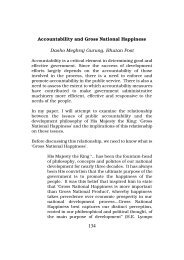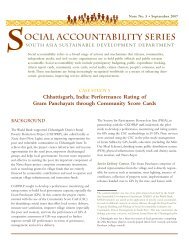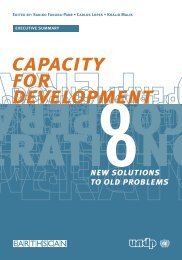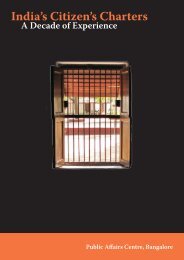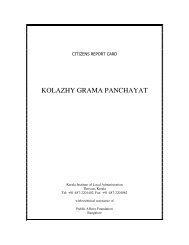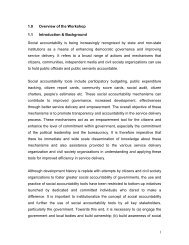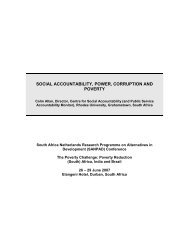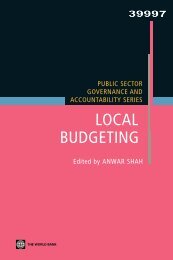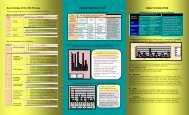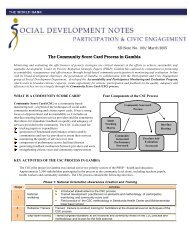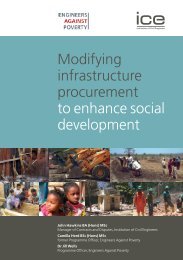Enabling Environment for Social Accountability in ... - SASANet
Enabling Environment for Social Accountability in ... - SASANet
Enabling Environment for Social Accountability in ... - SASANet
You also want an ePaper? Increase the reach of your titles
YUMPU automatically turns print PDFs into web optimized ePapers that Google loves.
Annex 6. Survey of Civil Society Organizations on<br />
the <strong>Enabl<strong>in</strong>g</strong> <strong>Environment</strong> <strong>for</strong> <strong>Social</strong> <strong>Accountability</strong> <strong>in</strong> Mongolia<br />
The Mongolian CSO Survey was conducted to assess the opportunities <strong>for</strong> and constra<strong>in</strong>ts on the ability<br />
of civil society organizations to <strong>in</strong>fluence the policies of the Government of Mongolia. The study was<br />
conducted <strong>in</strong> April-May 2005 by The Asia Foundation.103 Almost 100 CSOs were surveyed <strong>in</strong> two<br />
categories of respondents: a sample of randomly selected NGOs (35) registered with the M<strong>in</strong>istry of<br />
Justice and Home Affairs (MoJHA), and a list of “active” CSOs (61) identified <strong>in</strong> consultation with<br />
various NGOs, INGOs, and members of the donor community.<br />
The team decided to take a dual approach because a survey of active CSOs would not reflect Mongolia’s<br />
larger CSO environment, where access to resources (human and f<strong>in</strong>ancial) and public officials is<br />
markedly reduced. On the other hand, a random sample of registered NGOs would not reflect the dynamic<br />
<strong>in</strong>volvement of Mongolian CSOs <strong>in</strong> civic engagement and social accountability. Moreover, the team was<br />
uncerta<strong>in</strong> at the outset whether TAF would ga<strong>in</strong> access to the MoJHA list, and if it could, whether it<br />
would be able to locate most of these organizations and obta<strong>in</strong> their participation <strong>in</strong> the survey.104 In the<br />
end, the survey is heavily dom<strong>in</strong>ated by CSOs located <strong>in</strong> Ulaanbaatar (93 percent). This does not reflect a<br />
bias <strong>in</strong> the survey, however, because accord<strong>in</strong>g to the MoJHA 90 percent of registered NGOs are based <strong>in</strong><br />
the capital, although only 50 percent of the population resides there.<br />
A greater number of respondents would have enhanced the survey, particularly respondents from the<br />
underrepresented prov<strong>in</strong>ces as well as <strong>in</strong><strong>for</strong>mal organizations. Nevertheless, the f<strong>in</strong>d<strong>in</strong>gs from the survey<br />
have been very <strong>in</strong><strong>for</strong>mative, confirm<strong>in</strong>g and clarify<strong>in</strong>g the qualitative research conducted <strong>for</strong> the study.<br />
I. ORGANIZATIONAL INFORMATION<br />
To assess the scope of civil society organizations <strong>in</strong>volved <strong>in</strong> civic engagement, we need some basic<br />
<strong>in</strong><strong>for</strong>mation about your organization.<br />
In what year was your organization established? 105<br />
Prior to the 1990 Transition 6%<br />
1990–96 29%<br />
1997–2004 55%<br />
No response 9%<br />
Location of ma<strong>in</strong> office (city or prov<strong>in</strong>ce) 106<br />
Ulaanbaatar 94%<br />
Other 6%<br />
103 Recent Politobarometer polls conducted by Sant Maral are available at the Open Society Forum Web site www.sorros.org.mn.<br />
104 In fact, the refusal rate <strong>for</strong> the randomly selected NGOs was nearly double the rate <strong>for</strong> active CSOs. Moreover, the list of<br />
NGOs provided by the MoJHA frequently had outdated or <strong>in</strong>sufficient <strong>in</strong><strong>for</strong>mation, <strong>for</strong>c<strong>in</strong>g TAF to take the next NGO on the list.<br />
105 We also asked the year <strong>in</strong> which CSOs were registered, but given that responses closely corresponded to the reported date, and<br />
a third of the respondents gave registration dates prior to the 1997 legislation that set up NGO registration, this question was<br />
dropped from our analysis.<br />
106 The UB-bias reflects that the category of pre-identified “active” NGOs, which constitute more than 60 percent of the<br />
respondents, is based <strong>in</strong> the capital. It is also a product of <strong>in</strong>complete or outdated contact <strong>in</strong><strong>for</strong>mation from the MoJHA on NGOs<br />
outside of UB, as well as the fact that most NGOs are based <strong>in</strong> UB.<br />
101




